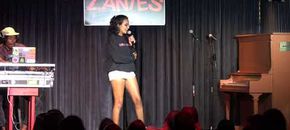Movie Review: Leonardo DiCaprio Howls In ‘The Wolf of Wall Street’

Martin Scorsese is no stranger to stories of decadence. He made his name directing films about self-destructive characters — whether it’s mob flick Goodfellas or Jake LaMotta biopic Raging Bull — but The Wolf of Wall Street may top them all in terms of true depravity. Tackling another biopic, this time about disgraced stockbroker Jordan Belfort, it’s his fifth collaboration with star Leonardo DiCaprio, and also stands as his funniest film since 1983’s The King of Comedy.
Leonardo DiCaprio stars as Belfort and boasts a career best performance as he transforms from a naive kid looking to make it rich on Wall Street, to a drug-addled, sex-addicted, and corrupted head of a stock firm. Clocking in at three hours, Scorsese is more interested in mining the minutiae of Belfort’s descent into debauchery to create an atmosphere of innocence lost, rather than tell a straight morality tale of Belfort’s rise and fall. Scorsese balances the increasingly erratic behavior of Belfort and his cohorts — including the dental implanted Jonah Hill as Donnie Azoff, his second in command — with a dark, wry humor not seen since the aforementioned The King of Comedy.
Written by Boardwalk Empire creator Terence Winter, it has the feel of a longer work edited into a film, and yet that doesn’t diminish its final impact. Some of the most accomplished and uproarious scenes have little to do with moving the plot forward, but instead layer on how outrageous Belfort and his friends’ lives have gotten. Much of the film is Belfort attempting to balance his insatiable greed with a similar wolfish appetite for women and drugs. As his firm Stratton Oakmont builds from a ragtag crew out of a garage into a legitimate Wall Street corporation, it’s set against a backdrop of orgies and a constant intake of drugs. But as truly outrageous, and at times downright disgusting, Belfort’s odyssey gets, DiCaprio only becomes more magnetic.
Belfort’s success comes when he’s introduced to penny stocks, which have a much bigger cut for the broker than the higher traded Wall Street sanctioned stocks, and begins to defraud his clients for large amounts of investments, to the amazement of the small Long Island office he infiltrates. The penny stock is akin to playing quarter slot machines instead of a high stakes blackjack game. But Belfort isn’t content playing for small potatoes and so begins the creation of his empire, as he develops a sales tactic that seems unable to fail. A chance meeting with the odd, bordering on creepy Azoff — he’s married to his first cousin after all — starts the ball rolling to him creating Stratton Oakmont.
Scorsese creates a film that recalls the similarly rapid fire Goodfellas crossed with DiCaprio’s Catch Me If You Can, but much dirtier and much, much funnier than either. DiCaprio is enthralling as Belfort, dominating every scene he’s in — which is almost every single one. Many memorable scenes involve his incredible intake of every and any drug he can get his hands on, including one sure to go down in cinematic history of his overdose on potent quaaludes. Jonah Hill is also cast perfectly as the eccentric Azoff who constantly matches Belfort’s hedonism and whose distractingly large and piercingly white teeth adds to the film’s quirkiness. Scorsese employs a strong cast throughout, including but not limited to the relative newcomer Margot Robbie as Belfort’s second wife Naomi, apparently oblivious to his life of overindulgence yet a perfect combatant when he deserves it.
While Scorsese definitely earns the long length of the film, there are parts, most notably the final third, that feel bloated. However, it’s obvious that he had so much great material to work with, that even the non-essential scenes of the film are captivating. For a director that has become synonymous with quality Hollywood films, a creator of the New Hollywood aesthetic, The Wolf of Wall Street is not only his most outrageous and, possibly, funniest work, but it also ranks high among one of the strongest bodies of works from any living American director.
Rating: 4 out of 5







